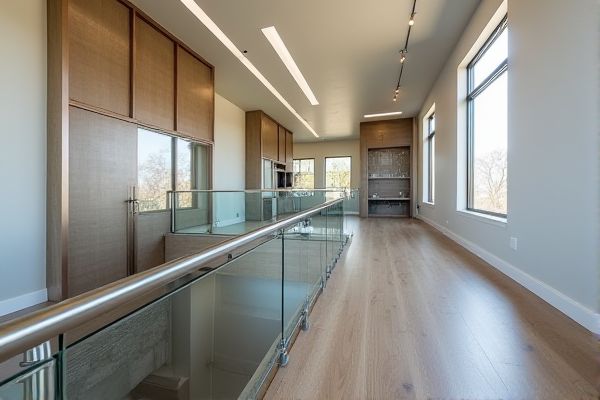
Glass railing offers a modern, sleek appearance with unobstructed views, while metal railing provides durability and a variety of design options for a more traditional or industrial look. Explore the full article to discover which railing type best suits your style and needs.
Table of Comparison
| Feature | Glass Railing | Metal Railing |
|---|---|---|
| Material | Tempered or laminated glass panels | Steel, aluminum, or wrought iron |
| Durability | Resistant to corrosion; susceptible to cracks | Highly durable; prone to rust without coating |
| Maintenance | Requires regular cleaning to prevent smudges | Needs periodic painting or rust prevention |
| Aesthetics | Modern, sleek, offers unobstructed views | Classic to industrial styles; customizable |
| Safety | Strong yet fragile impact resistance | Robust and impact-resistant |
| Cost | Higher upfront cost | Generally more affordable |
| Installation | Requires skilled labor with precision fitting | Relatively easier and faster installation |
| Environmental Impact | Recyclable glass; energy-intensive production | Metal recycling highly efficient; variable energy use |
Introduction to Glass and Metal Railings
Glass railings offer a modern, transparent barrier that enhances visibility and aesthetic appeal, often made from tempered or laminated glass panels supported by metal frames or clamps. Metal railings, commonly crafted from materials such as stainless steel, aluminum, or wrought iron, provide durability, strength, and a variety of design options ranging from traditional to contemporary styles. Both railing types serve safety and decoration purposes, with glass emphasizing openness and metal delivering structural robustness.
Aesthetic Differences: Glass vs Metal Railing
Glass railings offer a sleek, modern aesthetic with transparent panels that enhance natural light and provide unobstructed views, ideal for contemporary architectural designs. Metal railings, available in various finishes such as wrought iron, stainless steel, or aluminum, deliver a more traditional or industrial appearance, often featuring intricate patterns or bold lines that add character and durability. The choice between glass and metal railings significantly impacts the visual openness and style coherence of a space, influencing both indoor and outdoor ambiance.
Strength and Durability Comparison
Glass railings offer exceptional resistance to corrosion and weathering, making them ideal for outdoor settings, while tempered glass provides considerable strength but can be prone to impact damage compared to metal. Metal railings, especially those made from stainless steel or aluminum, provide superior tensile strength and longevity, often withstanding heavy loads and harsh environmental conditions without compromising structural integrity. Maintenance requirements differ, with glass needing regular cleaning to prevent scratches and metal requiring periodic treatment to avoid rust and maintain durability.
Safety Features of Glass and Metal Railings
Glass railings offer enhanced visibility and modern aesthetics, using tempered or laminated safety glass to prevent shattering and reduce injury risks. Metal railings, often made from stainless steel or aluminum, provide robust structural strength and resistance to impact, making them ideal for high-traffic areas requiring durable safety barriers. When choosing between glass and metal railings, consider your safety requirements alongside maintenance needs and local building codes.
Installation Process: Glass vs Metal Railing
Glass railing installation requires precise handling of tempered glass panels, secure mounting with specialized hardware, and careful alignment to ensure safety and aesthetic appeal, often demanding professional expertise. Metal railing installation involves welding or bolting metal components, which can be faster and more straightforward but requires corrosion protection and regular maintenance to prevent rust. Both types demand accurate measurements and compliance with building codes, though glass railings typically have higher initial installation complexity due to material fragility and hardware precision.
Maintenance Requirements for Each Option
Glass railings require regular cleaning to remove fingerprints, dirt, and water spots, using non-abrasive glass cleaners to maintain their clarity and shine. Metal railings, often made of steel or aluminum, need periodic inspection for rust or corrosion, followed by repainting or applying protective coatings to prevent deterioration. Your choice will impact maintenance frequency and materials, with glass offering easier daily upkeep but metal demanding more preventive care over time.
Cost Analysis: Glass Railing vs Metal Railing
Glass railing typically incurs higher initial costs due to material quality and installation complexity, with prices ranging from $75 to $120 per linear foot. Metal railing, such as aluminum or steel, offers a more budget-friendly alternative, averaging $40 to $85 per linear foot, while providing durability and lower maintenance expenses over time. Your choice should weigh upfront investment against long-term durability and aesthetic preferences for the most cost-effective solution.
Best Applications: Where Each Railing Excels
Glass railing excels in modern architectural settings where unobstructed views and natural light enhancement are priorities, making it ideal for balconies, pool enclosures, and staircases in residential and commercial spaces. Metal railing offers superior durability and strength, making it best suited for high-traffic areas, outdoor staircases, and industrial environments requiring robust safety features and low maintenance. Both materials provide aesthetic versatility, but glass prioritizes transparency and elegance, while metal emphasizes structural integrity and security.
Environmental Impact and Sustainability
Glass railings made from recycled materials offer high durability and are fully recyclable, reducing environmental footprint and supporting sustainable construction practices. Metal railings, especially those crafted from aluminum or steel, are highly recyclable but often require energy-intensive mining and manufacturing processes that increase carbon emissions. Choosing materials with certified eco-friendly production and incorporating recycled content enhances the sustainability profile of both glass and metal railings in building projects.
Choosing the Right Railing for Your Project
Glass railing offers a modern, transparent aesthetic that enhances visibility and creates an open, spacious feel, making it ideal for residential decks or balconies with scenic views. Metal railing provides exceptional durability, strength, and versatility in design, suitable for high-traffic areas and commercial projects requiring long-lasting support and minimal maintenance. Selecting the right railing depends on factors such as safety requirements, maintenance preferences, climate exposure, and the desired architectural style for your specific project.
 homyna.com
homyna.com